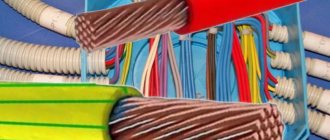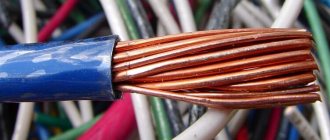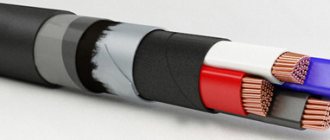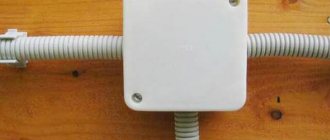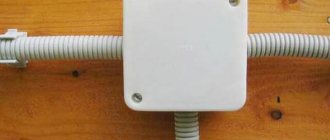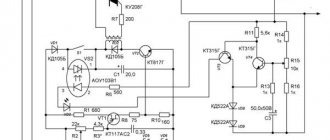The industry does not stand still. Old technologies are being brought to perfection, new ones are being born. Every day the number of electrical tools and household appliances operating from a 220/380 V network is significantly increasing. Accordingly, there is a need to use a unified, standard cable that could be used to connect electrical appliances to the network. Looking ahead, we note that this is what it is.
The specific choice is influenced by the features and operating conditions. It is important to choose the most durable, electrically and fireproof cable with increased flexibility and long service life. In addition to PVA, the best option for household appliances, there are other, less popular types of wires.
However, PVA can be operated at AC voltages up to 380 V, which is an ideal value for domestic use. Among the advantages, plasticity should be highlighted, which is influenced by the minimum bending radius. This allows you to maintain the integrity of the insulation and reduce the risk of ruptures of internal conductors.
Purpose and use of PVS
In general, the purpose of the cable can be judged based on the last letter of the marking - “C”, which stands for “connecting”. It turns out that the product is intended for switching electrical devices among themselves or connecting to a network.
The PVS wire is used mainly at home. It can be used to create several products:
- extension;
- switching of electrical devices;
- arrangement of temporary lighting systems.
The cable can often be found in various manufacturing plants where medium power equipment is switched, including lathes, power units and control terminals. PVA wire for domestic and industrial use differs in the number and cross-sectional area of the cores. A wide variety of options allows you to find the right model in accordance with your requirements and operating conditions.
Areas of application for vinyl insulated wires
PVA cable has found wide application as a conductor for connecting devices with low power. The ability to bend without damage at a small radius makes it a universal and indispensable element for the manufacture of household appliances.
In everyday life, it is applicable when connecting electrical appliances for various purposes to the network: air conditioners, vacuum cleaners, refrigerators, washing machines. It is also suitable for wiring in residential premises and for the operation of equipment in the field of gardening and horticulture, for specialized small-scale mechanization equipment.
Industrial production uses this type of cable at some stages. The property of withstanding a large number of kinks and being subject to deformation allows it to be used for the manufacture of extension cords (carriers) of different lengths, as well as for the installation of street lighting and illuminated advertising.
Decoding of PVA markings
It is quite simple to decipher the PVA:
- the letter “P” indicates that this product is a “wire”;
- the letter “B” means that the cores and sheath are protected with “polyvinyl chloride” (vinyl) insulation;
- “C” – “connecting” cable (purpose).
There are other wire options. For example, you can often find the PVSP label on store shelves. Many people mistakenly believe that we are talking about an identical cable, although in fact the cores of this model are located parallel to each other. As a result, the wire turns out to be oval in cross-section, and installers call it “flat”.
Any cable/wire must be marked on the outer surface. In addition to letter designations, there may be various numbers on the PVA shell:
- the first digit is used to indicate the number of cores, so the number will always be an integer - 2, 4, 5, 8, etc.;
- the second number indicates the cross-sectional area of an individual core - 0.25, 0.75, etc. (measured in sq. mm).
It will be much easier to understand by looking at examples. Let's assume that you see a cable marked PVS 4×0.75. Deciphering the meaning, we get “a connecting wire with polyvinyl chloride insulation and four cores with a cross-section of 0.75 square meters. mm for each." If the product is marked as PVSP 2×2.5, then this cable is a flat type of PVSP with two cores and a cross-section of 2.5 square meters. mm each.
There is more complex marking when the cable indicates “PVS 4×0.5+1×1.0. This wire has four cores with a cross section of 0.5 square meters. mm and one additional – 1.0 sq. mm.
Important! In accordance with GOST, small deviations are allowed between the actual and nominal values of the cross-sectional area of the wire. Thus, this value may be less or more than declared, while the electrical resistance must be the same as indicated in the technical data sheet. This is the main technical parameter!
Calculation of cable load
How much power can a cable with a cross section of 1.5-2.5-4-6 mm² withstand
? The safety of the house depends on how correctly the cross-section of the conductors is selected. You can’t just take some cable and connect an electric furnace to it. If its diameter is insufficient, the wiring will begin to heat up, which will lead to melting of the insulation, a short circuit and a fire.
For this reason, when installing electrical wiring, it is important to choose the correct cable cross-section. How much power can a wire with a cross section of 1.5-2.5-4 mm² withstand? What load can be connected to it? These are the questions that are often asked by those people who independently install electrical wiring.
Varieties
PVA can be divided into several varieties depending on the methods of operation and design. We are talking about internal and external, as well as copper and aluminum wires.
More details about each PVA option:
- The outer cable at least consists of three conductors, indicating phase, neutral and ground. This wire can be used to connect transformers and distribution panels.
- The internal one also consists of three cores, but is mainly used inside residential and industrial premises.
- Copper PVA is characterized by low resistance, elasticity and high strength.
- These indicators are no worse than those of aluminum cable. It is much cheaper, but is considered outdated technology.
The cost of a specific cable depends on several parameters:
- section;
- manufacturer;
- terms of Use;
- number of meters in the bay;
- technical execution;
- distance to the manufacturer (how much money was spent on transportation).
Design
Modern PVA wire consists of several intertwined copper wires with separate insulation made of high-quality polyvinyl chloride. Additionally, all conductors are protected by a PVC sheath. The standard cable has a round cross-section, although the PVSP model, as described above, will have an oval cross-section. Insulating materials may include various additives that give them additional protective functions (for example, the product does not support the combustion process).
Each copper core contains a large number of copper wires. When twisting each one, a dense rope is formed. In accordance with GOST, the class of lived in PVA must be at least fifth. Such a standard automatically regulates the minimum thickness of the wires from which a separate core is formed.
If the cross-section of each core in the cable is 1 sq. mm, then the diameter of the wires used should not be lower than 0.21 mm.
According to the standards specified in GOST, the wire can be produced in the following versions: with two, three, four or five cores. The cross-sectional area varies between 0.75-16 square meters. mm. Thicker types of cable are produced in specialized factories and are necessary for industrial use.
Analyzing GOST, you can discover another important rule: in PVA, the cores are twisted in the left direction, but the density is so high that filler is not used.
When choosing an insulating shell, manufacturers try to use materials of different colors, which simplifies installation tasks. Individual wires can be colored blue, brown, red, yellow or even yellow-green. The phase conductor is usually marked brown or red, the neutral conductor is blue or cyan, the ground conductor is double, yellow-green. The common sheath, under which all the cores are located, can have an arbitrary color (for example, black).
The top, outer layer is a polyvinyl chloride shell, which is applied using the extrusion method. During the single installation process, the protective layer does not support combustion. Due to its plasticity, the sheath fills any gaps formed between the cores, making the wire round in shape. The maximum eccentricity value is 10%.
Wire or cable
The state standard defines: a cable is a product whose insulated conductors are covered with a sheath protected by additional layers, including armor. Any type of installation is available, including suspended, in-ground, and underwater. Many protective layers and interlayers are allowed.
The technical characteristics of the presented product, while not providing strong protection, limit the conditions of use and do not allow use in open ground, especially under water. Formally called a wire.
Colors
Standards have been adopted around the world according to which manufacturers usually color conductor cores depending on their number, as well as the presence or absence of grounding.
The table below shows these standards:
| Number of cores | Color standard | |
| Grounding conductor – yes | Absent | |
| 2 | – | Brown and blue |
| 3 | Yellow-green, brown and blue | Black, brown and blue |
| 4 | Yellow-green, black, brown and blue | Blue, black, brown, black and brown |
| 5 | Yellow-green, blue, black, brown and black/brown | Blue, black, brown, black/brown, black/brown |
If any two colors are separated by a slash, then the right to choose a specific one remains with the manufacturer.
Depending on the color of the insulation, the cores have a unique purpose:
- blue color – neutral conductor;
- yellow-green – grounding;
- black or brown – phase.
Important! Often the phase core is painted white, which is also acceptable in accordance with international standards.
Design features of VVG 3x4
The table below shows the design features of the cable.
| Characteristic name | Unit change | Meaning |
| Number of cores | PC. | 3 |
| Maximum core diameter | mm | 2.4 |
| Cable outer diameter, 0.66 kV | mm | 11.6 |
| Cable outer diameter, 1 kV | mm | 12.8 |
| Weight Limit | kg/m | 0.271 |
| Core material | — | Copper |
| Insulation material | — | PVC |
| Shell material | — | PVC |
| Core construction type | — | OK |
Core design options:
- ok - single-wire core;
- mk - multi-wire core.
Operating conditions and technical specifications
An important condition for the operation of PVA wires of any model is maintenance in the operating temperature range, which ranges from -35 to +40 degrees. Celsius. If you follow this rule and exclude mechanical damage, the cable will last for ten years.
Due to its high technical and operational characteristics, PVS is significantly superior to wires of other brands. However, there is only one drawback - the price. However, the reasons for the higher cost are quite obvious.
We list the main technical parameters prescribed in GOST:
- For production, cores with a flexibility class of at least five are used. In accordance with this requirement, the cross-section of the wires used to form the core is selected. For example, 0.21 sq. mm each for a cable with cores of 1.0 sq. mm or 0.26 sq. mm for 2.5 sq. mm.
- The specific thickness of the insulating layer for an individual core and the entire wire as a whole depends on their cross-section. For cores, the thickness range is 0.6-0.8 mm, for sheath - 0.8-1.2 mm. When choosing this value, you need to focus on the electrical resistance specified in GOST.
- The operating temperature range of PVA wire is from -35 to +45 degrees. Celsius (for some versions below - from -25 to +40). The maximum permissible value when heating the cable is +70 deg. Celsius, and installation must be carried out at a temperature of at least -20 degrees. Celsius.
- The polyvinyl chloride shell is flame retardant but may crack when exposed to extreme cold or heat.
- The service life in accordance with GOST, subject to strict compliance with the conditions, is at least six years.
- The wire sheath should not have any visible defects, including bulges or dents. It is important to ensure that there is no free space between the cable cores, and if necessary, use additional materials as filler. In this case, the sheath is removed from the cores easily, without any difficulty.
Explanation of name, characteristics
The abbreviation stands for:
P – wire;
B – insulation and shell material polyvinyl chloride (vinyl, PVC);
C – purpose of the product – connecting.
Technical characteristics are determined by GOST 7399–97. The standard specifies the limits of acceptable values; the actual value is determined by specific production conditions and may differ slightly. The exact data is indicated in the manufacturer's product documentation. A sufficient understanding for practical work will be given by knowledge of the basic technical characteristics of the PVS wire:
- The maximum operating voltage with a frequency of 50 Hz of single-phase, three-phase networks is limited to 660 V;
- Operating temperature that does not lead to a violation of the strength properties of the insulation: -25 +40C°, short-term heating of +70C° is acceptable. “U” in the mark means the lower limit is -40C°;
- Permissible humidity is limited to 98%, operation of the product immersed in water is not allowed;
- A double-sided bend with a radius of 4 cm (section less than 1 mm²) or 6 cm will cause destruction in 30,000 cycles;
- Electrical insulation strength testing is carried out with an alternating voltage of 2 kV for 5 minutes. Insulation soaked in water for an hour is tested at the same voltage for 15 minutes;
- Does not spread fire when laid alone;
- Using many twisted thin cores, PVA cable is characterized by high elasticity, strength, and low resistivity.
Features of installation of PVA for laying in the ground and outside
The first thing you should pay attention to is that PVA wire is not intended for underground installation. If this is absolutely necessary, then the product should ideally be hidden inside a double-walled pipe. When laying cables outdoors, it is necessary to use corrugated pipes attached to walls and other surfaces of stationary objects. In this case, grounding must be carried out.
If you need to create an overhead power line using a PVA wire, then choose a cable exclusively with copper conductors. In this case, the distance between the beginning and end of the route should be minimal. Hidden wiring from PVC cable is unacceptable (it cannot be hidden under plaster).
Despite the fact that the cable has a short service life (for electrical wiring in a house, six years is really not enough), it can be used when laying under a screed. This option is appropriate if you want to save money on purchasing a higher quality and more durable wire. Thanks to a set of unique properties and protection from dust and moisture, PVA can be used in rooms with high humidity levels.
Additional insulation of the product using heat-shrinkable tubes is possible. However, even this option will not save the PVA cable, which cannot be used directly in water, since the insulation will still accumulate moisture. Since laying cable lines under a suspended ceiling is a hidden type, PVA wire in this case is again unacceptable.
Advantages and disadvantages
The positive qualities of PVA wire include:
- copper is a light metal, so the entire structure as a whole is characterized by minimal weight;
- possibility of use in electrical networks with a voltage of 220/380 V;
- increased flexibility, thanks to which the product can be laid on structures with sharp turns requiring a steep bend radius.
The disadvantages of PVA are associated with limited installation capabilities (hidden wiring or underground installation are not allowed). In general, due to the round shape of the cable, even with a strong desire to organize hidden wiring, you will encounter great inconvenience. Finally, the cost of PVA is higher in comparison with its analogues.
PVS cable compared to VVG
In terms of technical and operational characteristics, VVG is superior to PVA wire, however, these models have different purposes. When organizing electrical wiring in a house, apartment, or industrial facilities, it is best to use a VVG cable, since this is its main purpose.
PVA is used where VVG is inappropriate and can spoil the overall picture. Or in any other situations when it is inconvenient to operate the VVG cable due to its higher rigidity. For example, it would be difficult to imagine a VVG used to switch a microwave oven, iron or hair dryer. It looks ridiculous, extremely irrational, so in this case there is no alternative to PVA.
VVG also cannot be used when arranging temporary street lighting, constructing extension cords for connecting a lawn mower, cords for connecting boilers and expansion tanks. Thus, it is inappropriate to compare VVG and PVS in terms of technical parameters, since these conductors are designed to solve completely different problems.
Common cross-sections for wiring in an apartment
We talked a lot about names, materials, individual characteristics and even temperature, but we lost sight of life circumstances.
So, if you hire an electrician to conduct wiring in the rooms of your apartment or house, then the following values are usually accepted. For lighting, the wire cross-section is taken at 1.5 mm 2, and for sockets at 2.5 mm 2.
If the wiring is intended for connecting boilers, heaters, stoves, then the cross-section of the wire (cable) is already calculated individually.
How to choose PVS wire
The first thing you should pay attention to when choosing any electrical cable or wire is the number and cross-section of cores, selected in accordance with operating conditions. You need to select a PVA depending on the power of the electrical appliances that will be switched to the network through it. The presence or absence of a grounding conductor, which allows connecting the electrical appliance and the ground loop, is important. For example, when laying an industrial network, you need to use a PVA with four cores. At least, this is how it is stated in the rules of the PUE.
When inspecting the product, make sure that there are no defects in the insulation and that it is of proper quality. Test it for strength, since the insulation should not be damaged or torn by touch. Otherwise, the cable will not last long and will also pose a danger.
Each manufacturer must submit a sample of their wire. While studying it, make sure that the individual core is twisted correctly. Poor quality can be judged by the presence of stains, breaks, different colors and other defects that are visible to your eye. On the marking you can see not only the number of cores and their cross-sectional area, but also find out about the percentage of copper content.
To ensure safe and energy-efficient operation of electrical equipment, it is important to select the appropriate PVS wire. If you encounter any difficulties in the process of choosing a product, then seek help from professional installers or store consultants. However, you should not believe every word of the latter. Ideally, you should study the basic information regarding PVA and, armed with knowledge, go shopping.
Current loads in DC networks
In networks with direct current, the cross section is calculated somewhat differently. The resistance of a conductor to direct voltage is much higher than to alternating current (with alternating current, resistance at lengths of up to 100 m is generally neglected).
There is a formula that determines how much the voltage at the ends will drop compared to the base voltage, depending on the length of the conductor, its resistivity and the current in the circuit:
Knowing the values of these indicators, it is quite easy to calculate the cross section you need: by substitution method, or using simple arithmetic operations on this equation.
If the DC voltage drop at the ends does not matter, then to select the cross-section you can use the table for alternating current, but at the same time adjust the current values by 15% towards a decrease, i.e. with direct current, reference cable cross-sections can carry 15% less current than indicated in the table.
The cable that transmits electric current is one of the most important elements of the electrical network. If the cable fails, the operation of the entire system becomes impossible, therefore, to prevent failures, as well as the risk of fire from overheating, an accurate calculation of the cable cross-section for the load should be made.
This calculation gives confidence in the safe and reliable operation of the network and devices, but more importantly, the safety of people.
Choosing a cross-section that is insufficient for the current load leads to overheating, melting and damage to the insulation, and this, in turn, leads to a short circuit and even a fire. So there are many reasons to carry out calculations and carefully select the appropriate cable.
What is needed for load calculations
The main indicator that helps calculate the cross-section and brand of cable is the maximum permissible continuous load (current). To put it simply, this is the amount of current that the cable is capable of passing under the conditions of its installation without overheating for a sufficiently long time.
This requires a simple arithmetic summation of the powers of all electrical appliances that will be connected to the network.
The next important step to achieve safety is to calculate the cable cross-section for the load, for which it is necessary to calculate the current strength using the formula:
For a single-phase 220 V network:
For a three-phase network with a voltage of 380 V:
| Device name | Approximate power, W |
| LCD TV | 140-300 |
| Fridge | 300-800 |
| Vacuum cleaner | 800-2000 |
| Computer | 300-800 |
| Electric kettle | 1000-2000 |
| Air conditioner | 1000-3000 |
| Lighting | 300-1500 |
| Microwave | 1500-2200 |
Having received the exact current value, you should refer to tables that allow you to find a cable or wire of the required cross-section and material. But if the obtained current value does not exactly coincide with the table value, then you should not “save”, but rather choose the nearest, but larger value of the cable cross-section.
Example: with a network voltage of 220 V, the resulting current value was 22 amperes, the nearest larger value (27 A) is a copper wire or copper cable with a cross-section of 2.5 mm square. This means that the optimal choice would be just such a cable, and not with a cross-section of 1.5 mm square, which has a permissible continuous current of 19 A.
| Cross-section of current-carrying conductors, mm | Copper conductors of wires and cables | |||
| Voltage 220V | Voltage 380V | |||
| Current, A | power, kWt | Current, A | power, kWt | |
| 1,5 | 19 | 4,1 | 16 | 10,5 |
| 2,5 | 27 | 5,9 | 25 | 16,5 |
| 4 | 38 | 8,3 | 30 | 19,8 |
| 6 | 46 | 10,1 | 40 | 26,4 |
| 10 | 70 | 15,4 | 50 | 33 |
| 16 | 85 | 18,7 | 75 | 49,5 |
| 25 | 115 | 25,3 | 90 | 59,4 |
| 35 | 135 | 29,7 | 115 | 75,9 |
| 50 | 175 | 38,5 | 145 | 95,7 |
| 70 | 215 | 47,3 | 180 | 118,8 |
| 95 | 260 | 57,2 | 220 | 145,2 |
| 120 | 300 | 66 | 260 | 171,6 |
If you choose a cable with aluminum cores, then it is better to take a core cross-section of 4 mm square rather than 2.5.
| Cross-section of current-carrying conductors, mm | Aluminum conductors of wires and cables | |||
| Voltage 220V | Voltage 380V | |||
| Current, A | power, kWt | Current, A | power, kWt | |
| 2,5 | 20 | 4,4 | 19 | 12,5 |
| 4 | 28 | 6,1 | 23 | 15,1 |
| 6 | 36 | 7,9 | 30 | 19,8 |
| 10 | 50 | 11 | 39 | 25,7 |
| 16 | 60 | 13,2 | 55 | 36,3 |
| 25 | 85 | 18,7 | 70 | 46,2 |
| 35 | 100 | 22 | 85 | 56,1 |
| 50 | 135 | 29,7 | 110 | 72,6 |
| 70 | 165 | 36,3 | 140 | 92,4 |
| 95 | 200 | 44 | 170 | 112,2 |
| 120 | 230 | 50,6 | 200 | 132 |

